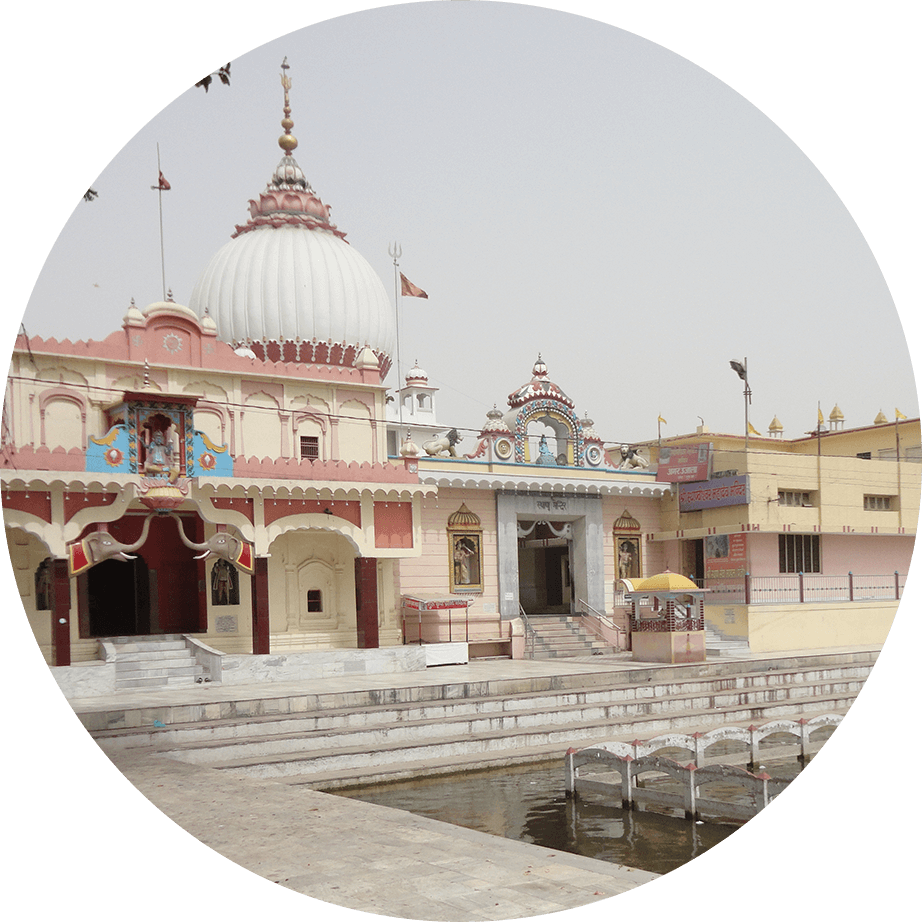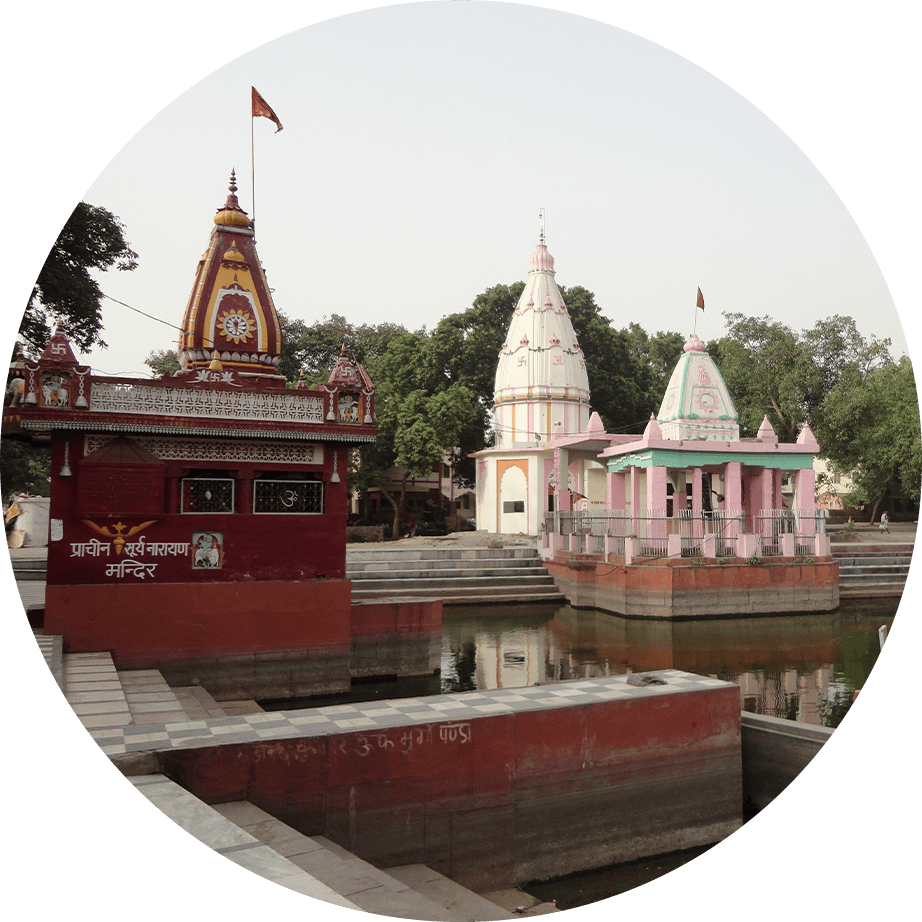Famous Places of Pilgrimage
Located 48 miles around the Kurukshetra some well-known pilgrimage places.
On the holy land of Kurukshetra, some of those whose importance is mentioned prominently in the above mentioned pilgrimages are being presented. Those whose names are taken in famous pilgrimage places. We start with the four gatekeepers or Yakshas of Kurukshetra and proceed in this direction –
Tarantuk Yaksha Sthal-Beed Peepli
According to the Vamana Purana and the Mahabharata, the Tarantuk or Rantuk Yaksha (near Beed Peepli) is situated in the north-east direction. This place is located at a distance of about 3km from Kurukshetra . It is counted as one of the four Yakshas of Kurukshetra. Here is the abode of Saraswati , has been regarded as one and the Muse enters Kurukshetra. As-
तत्र सा रंतुकं प्राप्य पुण्यतोया सरस्वती।
कुरूक्षेत्रं समाप्लाव्य प्रयाता पश्चिमां दिशम्।।
(वा.पु.-३३.२)
That is, “Hearing this, there, after getting the rantook from the Punyasilila Saraswati Dvaitavan, it enters Kurukshetra with speed and moves towards the west.”


Arntuk Yaksha Sthal-Bahr
Both Punjab and Haryana have a mixed cultural place – Bahr. It is located 40 km from Patiala and 24 km west of Kaithal . In the west from Kurukshetra the Arantuk Yaksha (near Behar village in Kaithal) is located in the village Bahr. Statues of several deities are enshrined in the full complex set up in the West in Bahar village. Of which the medieval statue of Lord Vishnu is particularly famous. This idol is made from sandstone. A huge fair is organized here on the day of Chaitra Amavasya. It is believed that these days Saraswati resides here.


Ramhrid Tirtha / Yaksha Sthal , Ramarai
To the south-west of Kurukshetra, Ramhrid is located near Ramarai in Yaks district Jind. It is also counted as one of the four Yakshas of Kurukshetra. There is also inhabited by Muse , is believed to Markandeya by Muse from Rntuk direct the future here Ramahrid Shrine / Direct site , was requested to go to Ram Rai.


Machkruk Yaksha , Seenkh
This Teertha is situated to the Southeast of Kurukshetra, in district Panipat’s Seenkh. In the 54th chapter of the Mahabharata, the below is described –
तरन्तुकारन्तुकयोर्यदन्तरं रामहृदानां च मचक्रुकस्य च।
एतत्कुरुक्षेत्रसमन्तपञ्चकं प्रजापतेरुत्तरवेदिरुच्यते।।५४-९-२८।।
That is, situated in the middle ofTarantuk and Arantuk, and also in between Ramhrid and Machkruk, this teerth is said to be Uttaravedi of Samantpanchak Pitamah (Prajapati Brahm).


Brahma Sarovar (Kurukshetra)
Brahmasarovar is the most prominent of the places in Kurukshetra whose fame has spread all over the world. There is mention about this pilgrimage in Mahabharata and Vamana Purana also –
आद्यंब्रह्मसरःपुण्यंततोरामहृदःस्मृतः।
That is, first of all, you should remember the virtuous Brahmasarovar and then Ramhrid. Something similar is also mentioned in the Vamana Purana-
ब्रह्मवत्र्ते नरः स्नात्वा ब्रह्मज्ञानसमन्वितः।
भवते नात्र संदेहः प्राणान् मुंचति स्वेच्छया।।
In which this pilgrimage has been linked to the Supreme Father Brahma ji. A huge fair is organized here on the occasion of solar eclipse. On this occasion, lakhs of people take bath in Brahmasarovar. Spread over several acres, this shrine is currently very beautiful and furnished. The Kurukshetra Development Board has provided a very scenic look and night lighting has also been arranged.


Sthaneshwar Mahadev Temple (Kurukshetra)
The name of Sthaneshwar Mahadev temple is taken with reverence in the temples of Kurukshetra, on the basis of this, the name here is named Thanesar. At this place Lord Shiva is worshiped in the form of Sthamsa. This place is considered to be one of the most popular 8 places of Lord Shiva’s beloved 68 places ; This is described in the Skandha Purana. The Narada Purana and is Arnit –
सरः प्रवेशात्संप्राप्तं स्थाणुत्वं शंभुनापि च ।।
पितुर्वधाच्च तप्तेन पशुरामेण भामिनि।।


Sannihit Sarovar (Kurukshetra)
Located on the Kaithal road in Kurukshetra, near the Shri Krishna Museum, with its main gate opening onto the main road. It is said that after the Mahabharat war, the Pandavas did pind-dan for the liberation of all those who lost their lives in the war. This lake is described in the Narada Purana –
सरः संनिहितं तच्च ब्रह्मणा निर्मितं पुरा।।
अथैषा ब्रह्मणो वेदी दिशमंतरतः स्थिता।।
It is described in the Vamana Purana that on the occasion of solar eclipse, there is a lot of merit here in doing the pind dan i.e. Shraaddh. Presently, temples of all the deities are located here. The ancient Lakshmi-Narayan temple is also located near this.


Ban Ganga (Kurukshetra)
Shortly before Jyotisar on Kurukshetra to Pehwa road, a route connected to the main road takes us to the village of Dayalpura where it islocated – Ban-Ganga. Here, Bhishma Pitamah, lying on the bed of arrows, was thirsty and Arjun fed water with the help of his arrows, from the earth. At present, a well has been constructed at the same spot and there is a huge statue of Lord Hanuman as well as a statue of Bhishma Pitamah lying on the bed of arrows.


Bhadrakali Shaktipeeth (Kurukshetra)
The Sri Devikupa (Bhadrakali) temple located in Kurukshetra is counted among the fifty two Shakti Peethas of Mother Sati. According to the scripture, Bhagwati Sati gave up her life after seeing the blasphemy and insult of her husband Lord Shankar in the Daksha-Yajna. Lord Shiva started roaming the universe with her dead body. Lord Vishnu with his Sudarshan Chakra divided the pious dead-body into fifty-two parts and distributed them to 52 locations for the benefit of mankind. Some of these 52 holy places are Naina Devi, Kamakhya Devi, Jwala ji etc.
This is the only Shaktipeeth in Haryana. The right ankle of Sati Ji in the temple reminds people of the ancient history. In this Shaktipeeth, before the war of Mahabharata, the Pandavas offered prayers to Mother Bhadrakali for victory. The Mundan rituals of Shri Krishna and Balarama also took place in this temple. Mother Bhadrakali fulfils the wishes of every devotee who comes to this temple.


Geeta janm Sthali (Jyotisar)
All over the world, India is famous for the knowledge of Srimad Bhagavad Gita. Knowledge of the Gita is considered to be the best in the spiritual realm. In the 47th verse of the second chapter, Lord Shri Krishna said –
कर्मण्येवाधिकारस्ते मा फलेषु कदाचन।
मा कर्मफलहेतुर्भूर्मा ते संगोऽस्त्वकर्मणि।।
At a place called Jyotisar, Arjuna was given the Gita Gyaan. Even today, there is a tree which is considered a witness to the Gita-knowledge. There is a Shivaling near it, on which one can still marks of blows during various attacks from foreign invaders and enemies. Apart from this, a number of pictures related to Mahabharata are also displayed here. An artificial lake has also been constructed here by the Kurukshetra Development Board to give Jyotisar a place of elegance and beauty and promote tourism.


Saraswati Tirtha (Pehwa)
Pehwa is a famous pilgrimage centre in the North West at a distance of 25 km from Kurukshetra. In reference to the importance of which Vamana Purana has written –
तस्माद्गच्छतपुण्यंतत्कुरुक्षेत्रंमहाफलम्।
तत्र पृथूदके तीर्थे पूज्यन्तां पितरोऽव्ययाः।। २१
Due to the confluence of Sapta Saraswati, Saraswati is an important pilgrimage. This place has also been given special status for Shraaddha and devotees from all over the world come here for Shraddha Karma. In the Saraswati Tirtha constructed here, lakhs of people take a dip on the occasion of Amavasya and perform shraaddh for their ancestors. Specific information about it is found in the Mahabharata and Puranas. According to Narada Purana –
लोलाकं जंबुमार्गे च सोमतीर्थं पृथूदके ।।
उत्पलावर्तके चैव पृथुतुंगे सकुब्जके।।६०-२५।।


Vriddh Kedar TeerthSthal (Kaithal)
Situated to the northeast of Kaithal, this shrine is of great importance. It has been developed as a beautigul lake. The Vamana Purana states that if a person offers prayers hee to Lord Shiva, and then drinks 3 sips of water, he gets the blessings of this shrine.
कपिलस्थेति विख्यातं सर्वपातकनाशनम्।
यस्मिन् स्थितः स्वयं देवो वृद्धकेदारसंज्ञितः।। पु ३६-१४
कपिष्ठलस्य केदारं समासाद्य सुदुर्लभम्।
अन्तर्धानमवाप्नोति तपसा दग्धकिल्विषम् ।। महावनपर्व ८३-७४
The Shiva temple here is octagonal. The turrets of the lake built here are also octagonal. It is also said in the Vamana Purana that an old god named Kedar is seated in a pilgrimage called Kapisthal.


Gyarah Rudri Mandir (Kaithal)
The Gyarah (eleven) Rudri Mandir is a famous and ancient temple to the west of Kaithal. Today this temple has been developed completely in a modern form. Its entrance looks very beautiful. Eleven Rudras have been established in this temple. This temple finds mention in the Mahabharata about the great sons of Lord Brahma, who were great sages named Mrigavyadh, Surp, Nikruti, Pinaki, Ahivuth, Ajaykpada, Dahan, Ishwar, Kapali, Stha nu, and Bhava. It is written in Mahabharata: –
एकादशसुताः स्थाणोः ख्याताः परमतेजसः।
मृगव्याधश्चसर्पश्च निऋतिश्चमहायशाः।
अजैकपादहिर्बुधन्यः पिनाकी च परंतप।
दहनोथेश्वरश्चैव कपाली च महाधुनिः।
स्थाणुर्भवश्च भगवान् रूद्रा एकादशस्मृताः।(महा.आदिपर्व६६/१-३)
Eleven Rudras have been established in this temple at Jalhari. To the south of the temple is a shrine called Sarvadeva, also called Sakalsar.


Kapil Muni Tirtha (Kalayat)
Kalayat village is at a distance of 25 km from Kaithal on the Narwana-Hisar route from Kaithal. This teerth is very important from a cultural point of view and is also mentioned in the scriptures. Katyayani temple and Sri Lakshmi Narayan temple are situated on the banks of this shrine. Apart from these, there is a Shiva temple built in Pancharatha style in about 7th century. A large fair is held here on the full moon of each month and especially once a year on the full moon day in Kartik month. It is believed that Kapil was born as an avatar. Kapil was the tenth child and first male child after nine daughters Devahuti, daughter of Maharaja Manu, and Lord Brahma’s human son, Kardam Rishi.
Another legend is famous about the Kapil Muni Teertha. It is said that King Shalyavan would sleep as a deceased in the night but wake up alive again the next morning. Once during a hunt, Kapil Muni shot an arrow into the shrine by mistake. When he began to remove the arrow, his fingers touched the soil of this Teertha. After touching the soil, his fingers remained active throughout the night. Impressed by this, the king and queen took a bath in this shrine the next day, which made them healthy. For this reason King Shalyavan built a temple here. A door made atthat time still exists in its original form.


Pundareek Tirtha Pundari
Pundareek Teerth is made in the name of the devotee Shiromani Pundarik. This place of pilgrimage is located at a distance of 16 km from Kaithal in the east. According to folk legends, the devotee, which praying to his lords, became a part of the Gods. In the end, his sinless body turned black and had 4 arms and held the conch, chakra, mace and padam. His clothes became yellow in color and the face of the body started shining brightly.
Due to which he was called Pundarikaksha and Lord Vishnu took him to Baikunthadham on his sacred vehicle the Garuda. According to the scriptures, Lord Vishnu created Brahma Ji from his naval lotus at this place and created the world. Siddha Baba Dandipuri, a small pond of Gyaraharudri Mahadev, Gita Bhawan, etc. are prominent parts of this great pilgrimage site. It is also mentioned in the Vanaparva and Vamana Purana of Mahabharata –
शुक्लपक्षे दशम्यां च पुण्डरीकं समाविशेत्।
तत्र स्नात्वा नरो राजन्पुण्डरीकफलं लभेत्।।
(महा.वनपर्व८३.८५-८६)
पौण्डरीके नरः स्नात्वा पुण्डरीकफलं लभेत् ।
दशम्यां शुक्लपक्षस्य चैत्रस्य तु विशेषतः।
स्नानंजपंतथाश्राद्धंमुक्तिमार्गप्रदायकम्।।
(वा.पु.३६.३९-४०)




